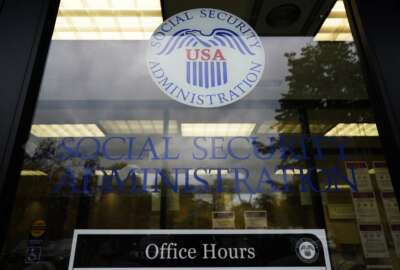Not getting out of the studio as much as I’d like, I looked forward to visiting Department of Homeland Security headquarters. The purpose of the visit: Check in on the Science and Technology Directorate, which moved to the St. Elizabeth’s site in Southeast D.C. Most of the employees telework.
It turned out to be an insightful view of how one agency is dealing with the post pandemic telework period. I spoke with Margie Rowe, the chief administrative officer of the directorate. Here’s how she described her job: “I take care of the facilities, the fleet, the mail, the personal property; part of keeping S&T running.”
S&T operates five labs throughout the Northeast U.S. Headquarters relocated to the DHS main campus in July. It occupies part of a new building attached to the original Saint E.’s structure, but with its own entrance. S&T had occupied space on Vermont Avenue in Northwest D.C., then briefly at 7th and D Streets NW. Rowe warned me all I would see is what she termed a cubicle farm, and that’s what I saw. She said about 10% to 15% of the headquarters staff comes in on a given day. Most of the cubes were empty.
More striking, none of them contained a single one of the personal items you normally see when touring cubicle farms — family photos, candy dishes, little potted plants, sports knickknacks, ratty sweater draped on the chair. Why? No one has an assigned cubicle. Everybody “hotels,” to use the vernacular. People reserve a spot to work for the days they come in.
In moving, the Science and Technology Directorate reduced its square footage, Rowe said, because it anticipated people would no longer work in the office en masse. At the labs, people mostly come in because they can’t do lab work from home. Last year I visited the Directorate’s Transportation Security Lab on the outskirts of the Atlantic City airport. One large room where researchers examine explosive materials looked like a cartoon version of a laboratory — boiling flasks, all sorts of piping, test tubes, Bunsen burners. Another room contained several experimental baggage screening machines. Clearly not telework situations.
In the old headquarters offices, Rowe said, “Everybody had their own office, everybody had all cabinets of paper.” While there, the COVID also moved in. “So we got people to go virtual. We worked with the CIO [office], installed Teams. So that allows us to do collaboration. And we reduced our footprint, so that we do a reservation system.”
DHS Under Secretary for Science and Technology Dimitri Kusnezov and his immediate staff have a permanent space. Security, facilities, personal property and computer help desk people also have space of their own. Different people perform receptionist duties throughout the week. But even Rowe teleworks and, despite her seniority, reserves a cube.
The archetype of an entry level job might be the mail clerk, the young person pushing a wheeled bin of paper through the halls. I asked Rowe if physical mail even comes in to virtual offices any more.
“You would be surprised,” she said. “Yes. We have mail that comes in every day.” She said S&T doesn’t have its own mail delivery people, though. That’s handled by DHS centrally since the office of the secretary lies upstairs and to the northwest of the S&T location.
Telework means people must come in if they want a printout. DHS disallows official documents flowing to personal printers in people’s homes, Rowe said.
I’ve always wondered about phones. Boomers like me who haven’t yet taken the cue to retire remember when phones all had a strictly physical location, and people mostly answered them. Rowe said her DHS corporate number rings through to Microsoft Teams on her cell phone.
Add it all up, and somehow at least this crucial federal component does fine, the incomprehensible April 2023 White House memo on telework notwithstanding.
In general, and perhaps not surprisingly, Rowe said the “lonely” days occur on Mondays and Fridays, although Director Kusnezov sometimes holds all-hands days. Science and Technology policy calls for staff to work in the office two days per pay period, or an average of one day a week. Contractor employees make up 60% of the 1,000 headquarters people who, in theory, could show up on the same day.
Nearly Useless Factoid
By: Michele Sandiford
St. Elizabeths is divided into two campuses. St. Elizabeths East campus was established by Congress in 1855 as the Government Hospital for the Insane.
Source: Government Accountability Office
Copyright
© 2024 Federal News Network. All rights reserved. This website is not intended for users located within the European Economic Area.





